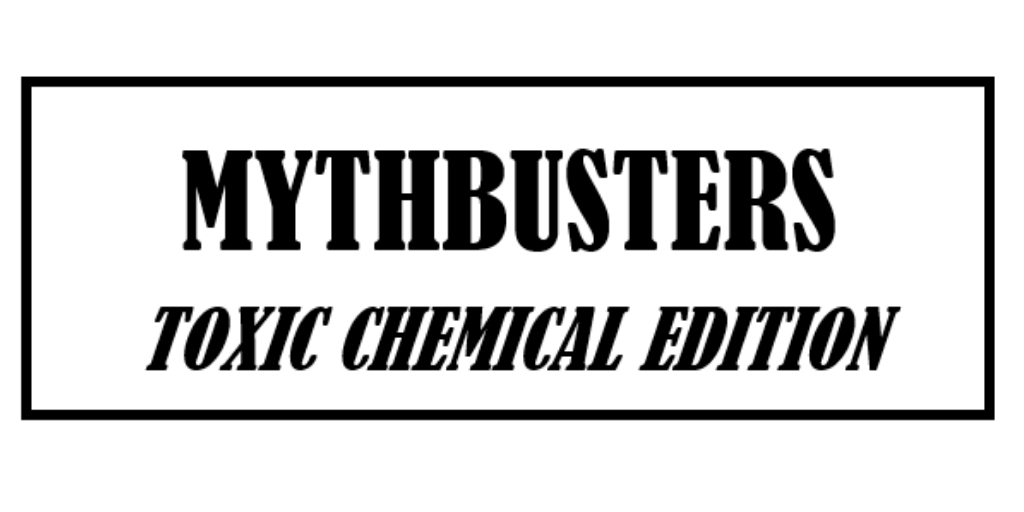
PART 2: Busting more industry-perpetrated myths about new chemicals and worker protection under TSCA
Richard Denison, Ph.D., is a Lead Senior Scientist.
[pullquote]This post shows why the chemical industry has been so anxious to convince EPA to defer to OSHA rather than regulate worker risks from new chemicals under TSCA.[/pullquote]
I started blogging last week about myths the chemical industry is perpetrating when it comes to EPA’s review of the risks new chemicals may present to workers. In this post, I address another such myth, one that the industry promotes to argue why the Environmental Protection Agency (EPA) can and should defer to the Occupational Safety and Health Administration (OSHA) in addressing the risks posed by new chemicals under the Toxic Substances Control Act (TSCA). This myth was on full display at last week’s House Energy & Commerce Committee hearing on EPA’s failures to protect workers from chemical risks.
Myth #2: OSHA regulations provide ample protection of workers from any exposures to new chemicals EPA is reviewing under TSCA.
In his hearing testimony, Mark Duvall of Beveridge & Diamond, currently a primary outside counsel to the chemical industry’s main trade association, the American Chemistry Council (ACC), and before that a longtime Dow Chemical attorney, made both broad and specific assertions that OSHA regulations will protect workers – and do so to an extent that is sufficient to meet TSCA’s requirements. He broadly asserted the following:
EPA has apparently based its “not likely to present” finding in part on the reasonable assumption that employers will comply with applicable OSHA requirements, and that compliance with OSHA requirements means that the PMN [premanufacture notification] substance is not likely to present an unreasonable risk to workers. …
In light of these applicable OSHA PPE [personal protective equipment] requirements, EPA concluded that the PMN substances for which it made “not likely to present” determinations were not likely to present an unreasonable risk even in the absence of a section 5(e) or section 5(f) order or a SNUR [Significant New Use Rule].
Duvall then specified the OSHA regulations to which he was referring. These include:
- OSHA’s hazard communication standard, 29 C.F.R. § 1910.1200
- OSHA’s general PPE standard, 29 C.F.R. § 1910.132
- OSHA’s standard for respiratory protection, 29 C.F.R. § 1910.134
- OSHA’s standard for glove use, 29 C.F.R. § 1910.138
This looks impressive at first glance. But the devil is in the details, in this case the major exceptions and caveats that apply to each regulation.
OSHA’s hazard communication standard (HCS): The HCS requires a company making a chemical to provide a Safety Data Sheet (SDS) identifying the chemical’s hazards and recommended precautions. The SDS is required to be made available to a company’s workers and to accompany a chemical if it is sold to customers downstream in a supply chain. However, the HCS does not impose ANY requirements on employers to implement those recommended precautions. This is made clear in the preamble to the final HCS (p. 17693, emphases added):
While the current HCS and this final standard require the provision of information on recommended control measures, including respiratory protection, personal protective equipment, and engineering controls, there is no requirement for employers to implement the recommended controls. An employer should use all available information when designing an appropriate protective program, but a recommendation on a safety data sheet by itself would not trigger the need to implement new controls.
OSHA’s general and specific PPE regulations: These regulations have two very important limitations as to when they are applicable and hence when use of PPE is mandatory: They apply only where the employer has determined that workers are subject to sufficient hazards from chemical exposures, and they apply only “where necessary.”
To illustrate, here is what OSHA’s general PPE standard states (emphases added):
Protective equipment, including personal protective equipment for eyes, face, head, and extremities, protective clothing, respiratory devices, and protective shields and barriers, shall be provided, used, and maintained in a sanitary and reliable condition wherever it is necessary by reason of hazards of processes or environment, chemical hazards, radiological hazards, or mechanical irritants encountered in a manner capable of causing injury or impairment in the function of any part of the body through absorption, inhalation or physical contact.
Similar caveats appear in the specific PPE standards. They mean that it is the employer who gets to decide both whether and what hazards exist and whether worker use of PPE is necessary. Let’s look closer at each of these factors.
Deciding whether a hazard exists
Under OSHA’s HCS, employers have considerable latitude in deciding whether a hazard exists in the workplace. Even a hazard classification of a chemical issued by an authoritative government body need not be relied on. That is, the employer can apply his/her own weight-of-evidence (WoE) approach to decide a chemical does not present a hazard even if a government authority has determined that it does. The employer can do so even if that government authority applied a WoE approach to make its hazard determination.
For example, for many chemicals, government authorities such as EPA’s Integrated Risk Information System (IRIS) or the National Toxicology Program (NTP) have reached determinations as to which human health hazards are posed by a particular chemical, such as whether a chemical is known or suspected to cause cancer in people. They do so by applying WoE approaches that have been subject to independent peer-review. Yet even where such a government body has classified a chemical as a carcinogen, under OSHA’s HCS and associated guidance a company can decide the chemical is not carcinogenic, by weighing the evidence differently using its own methodology.
This issue figured prominently in 2016, when OSHA took public comment on its draft “Guidance on Data Evaluation for Weight of Evidence Determination” as it related to changes OSHA made in 2012 to the HCS. In that draft, OSHA proposed to give deference to decisions made by authoritative bodies:
If a classifier reaches a final WoE conclusion that differs from that of the NTP or IARC [International Agency for Research on Cancer], OSHA would look, in the event of a compliance inspection, for a clear justification for the different classification. If OSHA disagrees with the classifier’s classification after evaluating the classifier’s justification, OSHA may issue a citation.
However, this and other language in the draft still retained the HCS’s approach of providing the company with the option of making its own determination that differs from that made by an authoritative body. And that determination would only be questioned in the rather unlikely event of a compliance inspection that focused in on this aspect of a company’s SDS.
An example of a company’s SDS substituting the company’s own conclusions about a chemical’s hazards for those of authoritative government bodies is this 2015 Dow Chemical SDS for methylene chloride, which asserts: “Methylene chloride is not believed to pose a measurable carcinogenic risk to humans when handled as recommended.”
This despite the following:
- EPA’s IRIS program 2011 weight-of-evidence characterization determined that the chemical is “Likely to be carcinogenic to humans.”
- The National Toxicology Program’s latest (2016) Report on Carcinogens classifies the chemical as “Reasonably anticipated to be a human carcinogen.”
- The International Agency for Research on Cancer (IARC) classified the chemical in 2017 as “Probably carcinogenic to humans.”
EDF and numerous other commenters urged OSHA to require companies to rely on hazard classifications by authoritative bodies identified by OSHA for chemicals, where they exist. Unfortunately, it appears this guidance did not move forward.
(Of more than passing interest is that Dr. Nancy Beck, at the time a senior official at the ACC, authored ACC’s extensive comments on this draft OSHA guidance. ACC’s comments urged OSHA to allow companies to apply their own WoE approaches and reach different hazard classifications even where authoritative government bodies had already done so. Now that Beck is Principal Deputy Assistant Administrator in EPA’s TSCA office, she is centrally involved in the agency’s decisions that seek to defer worker risks to OSHA and that agency’s regulations.)
Deciding whether PPE is “necessary”
“Necessary” under OSHA’s statute is a very different animal than “necessary” under TSCA.
This matters enormously because the dangerous tack EPA has taken deems regulations developed by OSHA to be sufficient and defers to them as a basis for greenlighting new chemicals. This has several major consequences. First, it means EPA itself will rarely impose any mandatory worker protections on companies.
Second, an employer can decide that worker protections are not “necessary” under OSHA standards unless it believes there is clear evidence of a hazard. Usually, with a new chemical such evidence of hazards is limited or lacking altogether. In contrast, under TSCA the lack of sufficient information to evaluate a new chemical’s hazards and risks – in and of itself – mandates that EPA issue an order to address any potential risks pending receipt of the information (see TSCA section 5(e)(1)).
Third, in deciding whether a hazard necessitating protections exists, the company’s point of reference will be OSHA’s, not TSCA’s, safety standard. Here is how the two standards differ:
TSCA’s safety standard: First, the 2016 amendments to TSCA explicitly preclude EPA from considering feasibility or other non-risk factors when determining whether a chemical presents an “unreasonable risk,” including to workers. Moreover, in implementing TSCA (even before the amendments) and its other environmental statutes, EPA has generally sought to reduce population risks from chemicals in commerce that are carcinogens to below about one case per one million people, or in some cases one case per 100,000 people (see Appendix B of this 2004 National Academy of Sciences report). And the head of EPA’s TSCA office at the time the new law was passed indicated she expected the same approach would be taken under amended TSCA in identifying chemicals in commerce that “present an unreasonable risk” (see p. 184 here).
In the present case, we are talking about new chemicals not yet in commerce. For them, TSCA requires EPA to regulate the chemical even if it “may present an unreasonable risk” – which means an even lower level of risk should trigger regulatory action.
OSHA’s safety standard: In contrast, the Occupational Safety and Health Act allows OSHA to regulate only “significant” risks in the workplace. And as a result of the landmark 1980 Benzene case, for carcinogenic chemicals OSHA has interpreted as “significant” a risk of one or more cases per 1,000 workers (see Appendix B of the 2004 NAS report). This means that OSHA tolerates risks to workers from chemicals that are several orders of magnitude higher than are allowed under TSCA.
In addition, OSHA can only regulate workplace exposures where it is “feasible” to do so. In practice, OSHA has frequently concluded that it is infeasible to reduce workplace risks below or even down to the 1 in 1,000 level (again, see Appendix B of this 2004 National Academy of Sciences report), leaving workers at even greater risk than contemplated by the Benzene decision. Indeed, evidence cited at last week’s hearing indicated that actual workplace risks posed by many carcinogens are even higher than one case per 1,000 workers.
Now you can see why the chemical industry has been so anxious to convince EPA to defer to OSHA rather than regulate worker risks from new chemicals under TSCA.
***
In my next post I will look at the industry’s mythic claims that requirements for SDSs and use of PPE are effective and universally complied with. Stay tuned.












